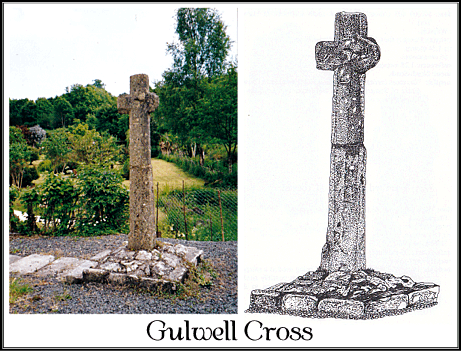
Just by the junction of West Street and the old Totnes road in the ancient stannary town of Ashburton stands a rather erect stone cross. Known as either Gulwell or St. Gudula’s Cross it’s clear that it has undergone some restoration in fairly recent years. Both names refer to the nearby ancient well – the Gulwell or St. Gudula’s Well which has been said to either have been named after a saint called Gudula or Gulwal. Either way it is the cross which is the focus of attention here, once again this cross, like many of Dartmoor’s ancient crosses has been dismembered, recycled and relocated.
William Crossing noted when writing about the cross that it: “Consists of the shaft only, and if it really was brought from the spring it must be long ago, for I learnt in 1892 from the late Mr. Perry, the owner of Gulwell, who was then eighty three years of age that it was in its present situation in the time of his grandfather.” At this time the shaft was well-worn and was serving as top stone of a mounting block, Harrison, p.160, and also showing evidence of two holes thus possibly indicating it had been used at some point as a gatepost. The head and arms of the cross were stashed away in one of the farm buildings upon part of which a cider vat was resting. p.107. A good few years later Harry Starkey went in search of the cross and found it standing in its present location. It had been restored in 1933 when it was presented to the parish of Ashburton. He also mentions that the original socket stone had been hollowed out and pressed into service as a trough which once stood under one of the towns water pumps. At some point in the 1950s when the pump was decommissioned the socket stone was broken up and used as infill for the well. p.115.

It has been suggested that the cross dates back to the 14th century when it stood sentinel over the holy well. Today as can be clearly seen the restored cross comprises of the head and arms with a section of shaft which has been joined to a longer section of shaft. As noted above it’s original socket stone has been destroyed so the cross is set into a bed of paved slabs and kerbs. It stands fairly tall amongst the Dartmoor crosses at a height of 2.21 metres. The arms span 91 centimetres and the shaft has a circumference of 31 centimetres. On one face of the head a slot has been cut which may well at some point of housed a small icon, on the other face is an incised cross which measures 21 by 23 centimetres.

Crossing, W. 1987. The Ancient Stone Crosses of Dartmoor. Exeter: Devon Books.
Harrison, B. 2001. Dartmoor Stone Crosses. Tiverton: Halsgrove Publishing.
Sandles, T. 1997. A Pilgrimage to Dartmoor’s Crosses. Liverton: Forest Publishing.
Starkey, F. H. 1983. Dartmoor Crosses. Callington: F. H. Starkey.
 Legendary Dartmoor The many aspects past and present of Dartmoor
Legendary Dartmoor The many aspects past and present of Dartmoor
